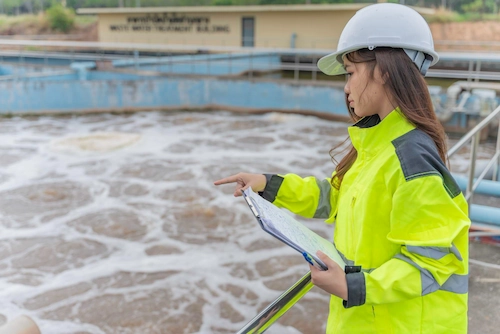Table of Contents
In managing industrial waste, an organization or company must have guidelines and planning documents called UKL-UPL. Then, what is UKL-UPL (Environmental Management and Monitoring Efforts)? UKL-UPL is a document ensuring that the operational process is still responsible for the environment. If you are interested in learning UKL-UPL, read the information below!
What Is UKL-UPL (Environmental Management and Monitoring Efforts)?

Did you know that the level of environmental pollution in Indonesia due to industrial activities is still high? According to the Ministry of Forestry, 45% of water pollution is caused by industrial waste and activity.
The government has established regulations regarding environmental analysis and management. As a result, business owners must prepare a UKL-UPL or AMDAL before obtaining an operational permit to prevent environmental damage caused by industrial activities.
UKL-UPL stands for Upaya Pengelolaan Lingkungan (Environmental Management Efforts) and Upaya Pemantauan Lingkungan (Environmental Monitoring Efforts). Both are important documents that contain technical guidelines and program plans for companies in managing and monitoring the environmental impact of their business activities.
In Indonesia, the administration and implementation of UKL-UPL are regulated in Law Number 32 of 2009 about Environmental Protection and Management. It is also emphasized in the Government Law Number 22 of 2021.
The regulations ensure that the company and its operations are not profit-oriented only, but are also responsible for the impacts on the environment. In general, UKL-UPL in the industry and business includes waste management (solid, liquid, and gas), reducing carbon footprint, and other efforts to prevent environmental pollution.
The government requires UKL-UPL documents as a form of environmental monitoring and control instrument. This is to ensure that every business activity continues to adhere to the principles of sustainable development and does not damage the surrounding ecosystem.
UKL and UPL are submitted by companies to the District/City Environmental Agency corresponding to the location of their business, under several predetermined requirements. The following are the requirements for submitting UKL-UPL:
- Application form.
- Company profile, deed of establishment, certificate of ownership, and MoU.
- Location maps, the building’s pictures, and the site plan.
- A water or air sample that has been tested in the lab.
- Program details regarding environmental management.
Benefits of UKL-UPL
UKL-UPL is a written form of the environmental guideline created by the business owner. This document not only works as an administrative requirement but also gives some benefits to the businesses. Here are the advantages of UKL-UPL documents:
1. Reducing the Environmental Impacts
Because UKL-UPL is a form of the owner’s responsibility towards the environment, this document plays a crucial role in ensuring that every operational process has been designed to minimize environmental impacts. That way, the production process can be planned to minimize the environmental risks.
2. Giving Management Guidelines
The UKL-UPL contains detailed environmental management plans, ranging from operational procedures and work standards to emergency response plans and environmental conflict mitigation measures.
With this document in place, all employees have clear guidelines for carrying out their environmental management responsibilities by established standards.
3. Becoming a Control Instrument
Not only is it useful for business operators, but it also serves as a control tool for the government. This document is the main reference for supervision, inspection, and environmental auditing. That way, business activities can be continuously monitored to ensure they remain in compliance with applicable regulations.
4. Building a Positive Image in the Public
Public awareness of environmental issues is now increasing. Therefore, companies that demonstrate a commitment to responsible environmental management will find it easier to build a positive image. In this case, UKL-UPL can be concrete evidence that a company is conducting its business with sustainability in mind. This makes it easier to gain public trust and support.
Read also: 7 Inorganic Waste Management Ideas, from Simple to Complex
A Glimpse of UKL-UPL Documents

According to its format, the UKL-UPL document usually includes several important components, such as the introduction, the identity of the initiator, business planning details, the environmental impacts analysis, the environmental monitoring plan, and a commitment letter from the business owner.
For example, the UKL-UPL document will include real environmental management, such as leveraging plastic waste into an eco-friendly asphalt mixture. Moreover, it is important to know that the UKL-UPL document is created before the business runs, which is during business planning. This document also becomes one of the main requirements in proposing operational and environmental permits.
In other words, the main function of the UKL-UPK documents is to ensure that every operational process is designed by considering the environmental impacts and the systematic monitoring efforts.
Functions of the UKL-UPL Document
Below are some main functions of UKL-UPL documents you must know:
1. Reducing the Environmental Impacts
With the UKL-UPL document, companies are required to analyze the impact of their business on the environment, such as water pollution, air pollution, ecosystem damage, or an increase in solid and hazardous waste.
Because this analysis is carried out from the planning stage, companies can design effective management strategies to avoid or reduce the negative impacts that may arise during the production process.
In addition, this document also contains plans for monitoring and evaluating environmental management programs. This allows companies to assess the success of their programs and take corrective action for betterment and improvement.
2. Fulfilling Permit Requirements
The UKL-UPL is one of the important documents that must be attached when you propose a business permit to the government. Through this document, business owners show that they have analyzed the environmental impact of their operational process as well as prepared strategies to overcome it.
3. Avoiding Conflicts
By preparing the UKL-UPL plan, a company has understood and is aware of the risk and the right mitigation. That way, they can mitigate the conflict with communities, the government, and other stakeholders.
4. The Government’s Monitoring Instrument
UKL-UPL works as the government’s control on monitoring businesses. This document can be the reference for determining whether a business has done its environmental responsibilities consistently or not.
Read also: What Is Circular Economy in Waste Management? Learn Here
The Difference between UKL-UPL, AMDAL, and SPPL
SPPL, AMDAL, and UKL-UPL are documents that must be prepared by business operators as a form of environmental responsibility. All three have similar functions of ensuring that business activities do not pollute the environment and remain within environmental protection.
AMDAL stands for Analisis Mengenai Dampak Lingkungan (Environmental Impact Analysis). This document is a comprehensive study of the potentially significant impacts that may be caused by a business plan or activity. It covers physical, chemical, biological, social, and economic aspects.
Typically, AMDAL is mandatory for large-scale companies and has a high risk to the environment, such as heavy industry projects, mining, airports, or large-scale residences. This mandate has been regulated in the Keputusan Menteri Lingkungan Hidup No. 05 Tahun 2012 about the business plan or activity with mandatory AMDAL.
On the other hand, SPPL, or Surat Pernyataan Kesanggupan Pengelolaan dan Pemantauan Lingkungan Hidup (Letter of Commitment to Environmental Management and Monitoring), is a written commitment for small-scale companies that do not require AMDAL or UKL-UPL. SPPL declares that the business owner agrees to manage and monitor the environment based on the regulations.
SPPL only applies to micro and small businesses, which have minimal impact on the environment, such as home businesses and simple services.
That concludes the information about UKL-UPL, including the definition, function, benefit, and the difference between other permit documents. In brief, those regulations are issued by the government to make sure that every business can operate their process while also paying attention to sustainability and not creating a negative impact on the environment.
Talking about protecting nature, if you are interested in becoming a game changer and contributing to a greener Earth, you can join Indonesia Asri. By participating as Warga Asri, you have a big chance to take part in many positive activities, like #AksiAsri. Let’s register yourself now for a greener Earth!
Read also: 6 Ways to Mitigate Soil Pollution, Easy and Effective








